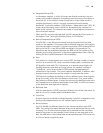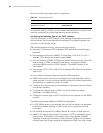OSPF 83
■ Designated Router (DR)
In a broadcast network, in which all routers are directly connected, any two
routers must establish adjacency to broadcast their local status information to
the whole AS. In this situation, every change that a router makes results in
multiple transmissions, which is not only unnecessary but also wastes
bandwidth. To solve this problem, OSPF defines a “designated router” (DR). All
routers send information only to the DR for broadcasting the network link
states to the network. This reduces the number of router adjacent relations on
the multi-access network.
When the DR is not manually specified, the DR is elected by all the routers in
the segment. See
“Setting the Interface Priority for DR Election”
■ Backup Designated Router (BDR)
If the DR fails, a new DR must be elected and synchronized with the other
routers on the segment. This process takes a relatively long time, during which
the route calculation is incorrect. To shorten the process, OSPF creates a BDR as
backup for the DR. A new DR and BDR are elected in the meantime. The
adjacencies are also established between the BDR and all the routers on the
segment, and routing information is also exchanged between them. After the
existing DR fails, the BDR becomes a DR immediately.
■ Area
If all routers on a large network are running OSPF, the large number of routers
results in an enormous LSD, which consumes storage space, complicates the
SPF algorithm, and adds CPU. Furthermore, as a network grows larger, the
topology becomes more likely to change. Hence, the network is always in
“turbulence”, and a large number of OSFP packets are generated and
transmitted in the network. This shrinks network bandwidth. In addition, each
change causes all the routers on the network to recalculate the routes.
OSPF solves this problem by dividing an AS into different areas. Areas logically
group the routers, which form the borders of each area. Thus, some routers
may belong to different areas. A router that connects the backbone area and a
non-backbone area is called an area border router (ABR). An ABR can connect
to the backbone area physically or logically.
■ Backbone Area
After the area division of OSPF, one area is different from all the other areas. Its
area-id is 0 and it is usually called the backbone area.
■ Virtual link
Since all the areas should be connected logically, virtual link is adopted so that
the physically separated areas can still maintain logical connectivity.
■ Route summary
An AS is divided into different areas that are interconnected through OSPF
ABRs. The routing information between areas can be reduced by use of a route
summary. Thus, the size of routing table can be reduced and the calculation
speed of the router can be improved. After finding an intra-area route of an
area, the ABR looks in the routing table and encapsulates each OSPF route into
an LSA and sends it outside the area.


















